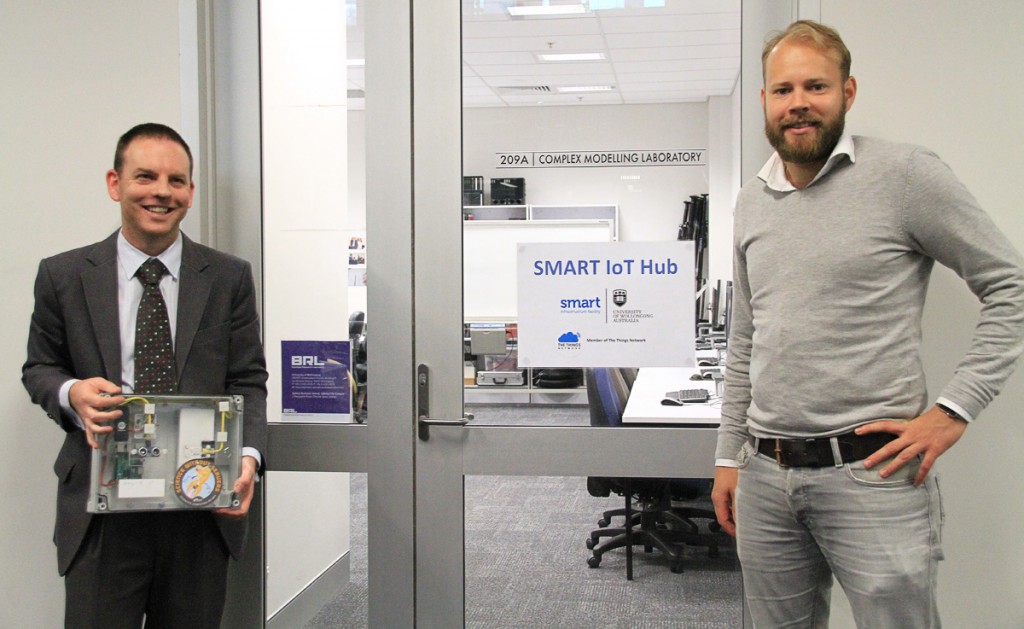We often talk about infrastructure – these days increasingly about smart infrastructure – but how often do we pause and think about what ‘infrastructure’ is for – or what ‘smart’ is? We think about roads and railways, energy, communications and water infrastructure as serving some purpose, such as moving traffic from A to B, or supplying sufficient energy to keep the lights on, but there is a more fundamental question: why do we need to do these things? Given the amount of money (that should be) invested in infrastructure, perhaps we should be asking such a fundamental question before we start proposing what should be built. Continue reading
Author Archives: Jessica Symonds
SMART takes steps to advance local Internet of Things networks, devices and knowledge

Dr Matthew Berryman, IT Architect, SMART Infrastructure Facility, University of Wollongong (right) together with Mr Wienke Giezeman, Initiator, The Things Network, launched the new Internet of Things (IoT) Laboratory at SMART Infrastructure Facility on Wednesday, 31 August 2016.
As sensors become smaller and cheaper and networks become more expansive and accessible, more and more things are being created with data capabilities. Continue reading
Closed-loop supply chain decisions using game theoretic particle swarm optimization
Closed loop supply chain management (CLSCM) is a relatively new field in the area of supply chain management and logistics which involves all the reverse logistics activities in addition to the forward logistics, like product acquisition, remanufacturing, redistribution, disposal etc. Continue reading
A spatial mircosimulation model to forecast health needs of elderlies in 2030 for Belgium (work in progress)
The forecasting of the population’s health needs is a big challenge in the current society, since the proportion of elderlies within the population is continually increasing. To allow each older person to live in a good health, health services need to be adapted. The project Virtual Belgium in Health (VBIH) aims to develop a platform based on a spatial micro-simulation that will approximate the health needs of elderlies in Belgium for 2030. Continue reading
Assessing the vulnerability of hydrological infrastructure to flood damage in coastal cities
 By Robert Ogie
By Robert Ogie
Hydrological infrastructure such as pumps, floodgates (or sluice gates), dams, embankments, and other flood barriers are invaluable assets used in coastal cities for mitigating flooding. These infrastructure components are often vulnerable to damage or failure due to the impact of floodwaters, thus exacerbating the flood hazards and causing significant loss of life and destruction to property worth billions of dollars. Continue reading
From big data to smart data
 By Dr Jack Yang
By Dr Jack Yang
In the past decade, with the exponential data accumulation, the challenges associated with the big four “V” problems – data volume (number of records), variety (different data formats), velocity (streaming data), and veracity (data uncertainty) – continue to multiply. Continue reading
High Performance and Cloud Computing at SMART Infrastructure Facility
What are High Performance Computing and Cloud Computing?
High performance computing is where we connect lots of smaller computers (compute nodes) via very high-speed connections into one machine that we can treat, using special software, almost as if it’s just a single very big computer. Continue reading
A quick refresher course in how to create jobs
 By Joe Branigan
By Joe Branigan
Some of Australia’s best public policy minds meet in Brisbane today for the Queensland Jobs Growth Summit. Continue reading
Of trucks, traffic, trees and fair trade
This blog is continued from Thinking Systems #11.
I have just spent a month in UK and have had time to reflect on the changes I have observed there since I was a child in Devon. This time our stay in England corresponded with the summer holiday period and, while the weather was awful, the traffic was worse. Continue reading
SMART as an eResearch toolmaker: Fuelling the knowledge economy
 By Tim Davies
By Tim Davies
Armed with a poster I recently attended the 2015 eResearch conference in sunny Brisbane. The eResearch conference usually brings together the best and brightest eResearchers from across the globe and this year was no exception. The theme of the conference was ‘Fuelling the Knowledge Economy’ the fuel in this case was the stimulating discussions and presentations centring around new information-centric research capabilities. SMART joined in on these discussions with a captivating poster that illustrated many of the eResearch capabilities that the SMART infrastructure Facility has to offer. Continue reading





